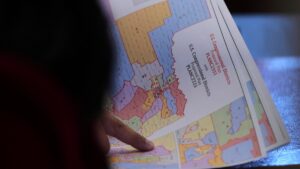Texas redrew its voting map as part of US President Donald Trump’s plan to win extra Republican seats in the 2026 midterm elections.
Published On 22 Nov 2025
The United States Supreme Court has temporarily blocked a lower court ruling that found the Texas 2026 congressional redistricting plan likely discriminates on the basis of race.
The order signed on Friday by Supreme Court Justice Samuel Alito will remain in place at least for the next few days while the court considers whether to allow the new map, which is favourable to Republicans, to be used in the US midterm elections next year.
Recommended Stories
list of 4 itemsend of list
Texas Attorney General Ken Paxton hailed the ruling, which had granted an “administrative stay” and temporarily stopped the lower court’s “injunction against Texas’s map”.
“Radical left-wing activists are abusing the judicial system to derail the Republican agenda and steal the US House for Democrats. I am fighting to stop this blatant attempt to upend our political system,” Paxton said in an earlier post on social media.
Texas redrew its congressional map in August as part of US President Donald Trump’s efforts to preserve a slim Republican majority in the House of Representatives in next year’s mid-term elections, touching off a nationwide redistricting battle between Republicans and Democrats.
The new redistricting map for Texas was engineered to give Republicans five additional House seats, but a panel of federal judges in El Paso ruled 2-1 on Tuesday, saying that the civil rights groups that challenged the map on behalf of Black and Hispanic voters were likely to win their case.
The redrawn map was likely racially discriminatory in violation of US constitutional protections, the court found.
Nonprofit news outlet The Texas Tribune said the state is now back to using, temporarily, its 2025 congressional map for voting as the Supreme Court has not yet decided what map Texas should ultimately use, and the “legality of the map” will play out in court over the coming weeks and months.
Texas was the first state to meet Trump’s demands on redistricting. Missouri and North Carolina followed Texas with new redistricting maps that would add an additional Republican seat each.
To counter those moves, California voters approved a ballot initiative to give Democrats an additional five seats there.
Redrawn voter maps are now facing court challenges in California, Missouri and North Carolina.
Republicans currently hold slim majorities in both chambers of Congress, and ceding control of either the House or Senate to the Democrats in the November 2026 midterm elections would imperil Trump’s legislative agenda in the second half of his latest term in office.
There have been legal fights at the Supreme Court for decades over the practice known as gerrymandering – the redrawing of electoral district boundaries to marginalise a certain set of voters and increase the influence of others.
The court issued its most important ruling to date on the matter in 2019, declaring that gerrymandering for partisan reasons – to boost the electoral chances of one’s own party and weaken one’s political opponent – could not be challenged in federal courts.
But gerrymandering driven primarily by race remains unlawful under the US Constitution’s 14th Amendment guarantee of equal protection under the law and 15th Amendment prohibition on racial discrimination in voting.
https://www.aljazeera.com/news/2025/11/22/us-supreme-court-blocks-order-on-likely-racial-bias-in-new-texas-voter-map?traffic_source=rss



